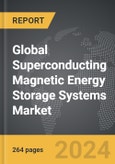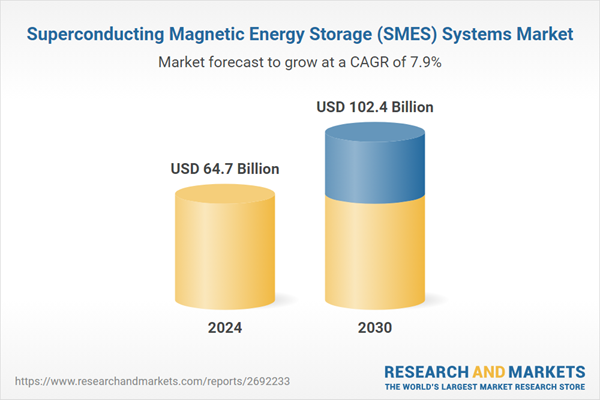The global market for Superconducting Magnetic Energy Storage (SMES) Systems was valued at US$64.7 Billion in 2024 and is projected to reach US$102.4 Billion by 2030, growing at a CAGR of 7.9% from 2024 to 2030. This comprehensive report provides an in-depth analysis of market trends, drivers, and forecasts, helping you make informed business decisions.
The high efficiency of SMES systems, with end-to-end efficiencies approaching 100%, marks a significant advantage over other energy storage options such as lithium-ion batteries or pumped hydroelectric systems, which typically show lower efficiencies. SMES systems stand out for their rapid response times, capable of quick charging and discharging that suits applications requiring precise power management. These characteristics make SMES particularly valuable in settings such as semiconductor manufacturing or medical facilities, where even slight improvements in energy efficiency can lead to substantial cost savings and operational enhancements. The ability of SMES systems to quickly release stored energy makes them an ideal solution for managing load imbalances and ensuring the stability of power grids, particularly when integrated with intermittent renewable energy sources like solar and wind.
Despite their potential, SMES systems face several challenges that hinder their widespread adoption. The high cost of superconducting materials and the complex infrastructure required for cryogenic cooling systems to maintain superconductivity contribute to significant initial investment and operational costs. Moreover, the scalability of SMES systems is currently limited by these high costs and the complex manufacturing processes required for the superconducting materials used. However, ongoing advancements in the development of high-temperature superconductors hold promise for reducing these costs and improving the feasibility of SMES systems for broader applications. If these materials can be engineered to function at higher temperatures and manufactured on a larger scale, SMES technology could revolutionize energy storage, contributing to a more sustainable and efficient global energy infrastructure. The growing demand for high-performance power management and the integration with renewable energy sources, along with supportive regulatory and government incentives, are poised to drive the growth and acceptance of SMES systems in the market.
Global Superconducting Magnetic Energy Storage (SMES) Systems Market - Key Trends and Drivers Summarized
Superconducting Magnetic Energy Storage (SMES) systems represent a sophisticated approach to energy storage that could significantly transform how energy is preserved and utilized globally. By storing energy in the magnetic field created by the flow of direct current (DC) through a coil made from superconducting materials, SMES systems harness the unique property of zero electrical resistance found in these materials. This allows for energy to be stored indefinitely without loss, providing a highly efficient means of energy conservation. The system operates by converting alternating current (AC) from an external source to DC, which energizes the superconducting coil, generating a robust electromagnetic field that acts as the storage medium. Maintaining the superconducting state involves cooling the material below a critical temperature to ensure zero resistance and, consequently, no energy loss.The high efficiency of SMES systems, with end-to-end efficiencies approaching 100%, marks a significant advantage over other energy storage options such as lithium-ion batteries or pumped hydroelectric systems, which typically show lower efficiencies. SMES systems stand out for their rapid response times, capable of quick charging and discharging that suits applications requiring precise power management. These characteristics make SMES particularly valuable in settings such as semiconductor manufacturing or medical facilities, where even slight improvements in energy efficiency can lead to substantial cost savings and operational enhancements. The ability of SMES systems to quickly release stored energy makes them an ideal solution for managing load imbalances and ensuring the stability of power grids, particularly when integrated with intermittent renewable energy sources like solar and wind.
Despite their potential, SMES systems face several challenges that hinder their widespread adoption. The high cost of superconducting materials and the complex infrastructure required for cryogenic cooling systems to maintain superconductivity contribute to significant initial investment and operational costs. Moreover, the scalability of SMES systems is currently limited by these high costs and the complex manufacturing processes required for the superconducting materials used. However, ongoing advancements in the development of high-temperature superconductors hold promise for reducing these costs and improving the feasibility of SMES systems for broader applications. If these materials can be engineered to function at higher temperatures and manufactured on a larger scale, SMES technology could revolutionize energy storage, contributing to a more sustainable and efficient global energy infrastructure. The growing demand for high-performance power management and the integration with renewable energy sources, along with supportive regulatory and government incentives, are poised to drive the growth and acceptance of SMES systems in the market.
Report Scope
The report analyzes the Superconducting Magnetic Energy Storage (SMES) Systems market, presented in terms of market value (USD). The analysis covers the key segments and geographic regions outlined below.Segments
Segment (Superconducting Magnetic Energy Storage (SMES) Systems).Geographic Regions/Countries
World; United States; Canada; Japan; China; Europe (France; Germany; Italy; United Kingdom; Spain; Russia; and Rest of Europe); Asia-Pacific (Australia; India; South Korea; and Rest of Asia-Pacific); Latin America (Argentina; Brazil; Mexico; and Rest of Latin America); Middle East (Iran; Israel; Saudi Arabia; United Arab Emirates; and Rest of Middle East); and Africa.Regional Analysis:
Gain insights into the U.S. market, valued at $17.4 Billion in 2024, and China, forecasted to grow at an impressive 11.5% CAGR to reach $22.2 Billion by 2030. Discover growth trends in other key regions, including Japan, Canada, Germany, and the Asia-Pacific.Why You Should Buy This Report:
- Detailed Market Analysis: Access a thorough analysis of the Global Superconducting Magnetic Energy Storage (SMES) Systems Market, covering all major geographic regions and market segments.
- Competitive Insights: Get an overview of the competitive landscape, including the market presence of major players across different geographies.
- Future Trends and Drivers: Understand the key trends and drivers shaping the future of the Global Superconducting Magnetic Energy Storage (SMES) Systems Market.
- Actionable Insights: Benefit from actionable insights that can help you identify new revenue opportunities and make strategic business decisions.
Key Questions Answered:
- How is the Global Superconducting Magnetic Energy Storage (SMES) Systems Market expected to evolve by 2030?
- What are the main drivers and restraints affecting the market?
- Which market segments will grow the most over the forecast period?
- How will market shares for different regions and segments change by 2030?
- Who are the leading players in the market, and what are their prospects?
Report Features:
- Comprehensive Market Data: Independent analysis of annual sales and market forecasts in US$ Million from 2024 to 2030.
- In-Depth Regional Analysis: Detailed insights into key markets, including the U.S., China, Japan, Canada, Europe, Asia-Pacific, Latin America, Middle East, and Africa.
- Company Profiles: Coverage of players such as ABB Inc., American Superconductor Corporation, ASG Superconductors SpA, Babcock Noell GmbH, Beijing Innopower Superconductor Cable Co. Ltd and more.
- Complimentary Updates: Receive free report updates for one year to keep you informed of the latest market developments.
Some of the 23 companies featured in this Superconducting Magnetic Energy Storage (SMES) Systems market report include:
- ABB Inc.
- American Superconductor Corporation
- ASG Superconductors SpA
- Babcock Noell GmbH
- Beijing Innopower Superconductor Cable Co. Ltd
- Bruker Energy & Supercon Technologies
- Fujikura Ltd.
- Hyper Tech Research Inc.
- Luvata U.K. Ltd
- Nexans SA
- Southwire Company LLC
- Sumitomo Electric Industries Ltd
- SuNam Co. Ltd.
- Superconductor Technologies Inc.
- SuperPower Inc.
Table of Contents
I. METHODOLOGYII. EXECUTIVE SUMMARY2. FOCUS ON SELECT PLAYERSIII. MARKET ANALYSISIV. COMPETITION
1. MARKET OVERVIEW
3. MARKET TRENDS & DRIVERS
4. GLOBAL MARKET PERSPECTIVE
UNITED STATES
CANADA
JAPAN
CHINA
EUROPE
FRANCE
GERMANY
ITALY
UNITED KINGDOM
SPAIN
RUSSIA
REST OF EUROPE
ASIA-PACIFIC
AUSTRALIA
INDIA
SOUTH KOREA
REST OF ASIA-PACIFIC
LATIN AMERICA
ARGENTINA
BRAZIL
MEXICO
REST OF LATIN AMERICA
MIDDLE EAST
IRAN
ISRAEL
SAUDI ARABIA
UNITED ARAB EMIRATES
REST OF MIDDLE EAST
AFRICA
Companies Mentioned (Partial List)
A selection of companies mentioned in this report includes, but is not limited to:
- ABB Inc.
- American Superconductor Corporation
- ASG Superconductors SpA
- Babcock Noell GmbH
- Beijing Innopower Superconductor Cable Co. Ltd
- Bruker Energy & Supercon Technologies
- Fujikura Ltd.
- Hyper Tech Research Inc.
- Luvata U.K. Ltd
- Nexans SA
- Southwire Company LLC
- Sumitomo Electric Industries Ltd
- SuNam Co. Ltd.
- Superconductor Technologies Inc.
- SuperPower Inc.
Table Information
| Report Attribute | Details |
|---|---|
| No. of Pages | 264 |
| Published | February 2025 |
| Forecast Period | 2024 - 2030 |
| Estimated Market Value ( USD | $ 64.7 Billion |
| Forecasted Market Value ( USD | $ 102.4 Billion |
| Compound Annual Growth Rate | 7.9% |
| Regions Covered | Global |









